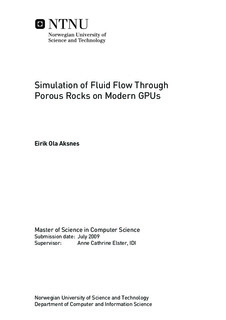Simulation of Fluid Flow Through Porous Rocks on Modern GPUs
Master thesis
Permanent lenke
http://hdl.handle.net/11250/251400Utgivelsesdato
2009Metadata
Vis full innførselSamlinger
Sammendrag
It is important for the petroleum industry to investigate how fluids flow inside the complicated geometries of porous rocks, in order to improve oil production. The lattice Boltzmann method can be used to calculate the porous rock's ability to transport fluids (permeability). However, this method is computationally intensive and hence begging for High Performance Computing (HPC). Modern GPUs are becoming interesting and important platforms for HPC. In this thesis, we show how to implement the lattice Boltzmann method on modern GPUs using the NVIDIA CUDA programming environment. Our work is done in collaborations with Numerical Rocks AS and the Department of Petroleum Engineering at the Norwegian University of Science and Technology. To better evaluate our GPU implementation, a sequential CPU implementation is first prepared. We then develop our GPU implementation and test both implementation using three porous data sets with known permeabilities provided by Numerical Rocks AS. Our simulations of fluid flow get high performance on modern GPUs showing that it is possible to calculate the permeability of porous rocks of simulations sizes up to 368^3, which fit into the 4 GB memory of the NVIDIA Quadro FX 5800 card. The performances of the CPU and GPU implementations are measured in MLUPS (million lattice node updates per second). Both implementations achieve their highest performances using single floating-point precision, resulting in the maximum performance equal to 1.59 MLUPS and 184.30 MLUPS. Techniques for reducing round-off errors are also discussed and implemented.
